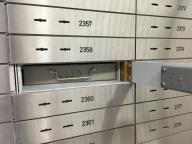In New York, banks will seal a safe deposit box following the death of an owner or co-owner. The bank will then only allow the safe deposit box to be opened after a Court issues an order to that effect. The following are the steps you must take:
1. Identify an interested party who can petition the court. An interested party can be the decedent’s spouse, beneficiary or a named fiduciary in the Will.
2. Identify the location of the safe deposit box. You may find this information in decedent’s papers, through conversations with decedent’s lawyer, or through contacting financial institutions near Decedent’s residence.
3. Petition the Court. You will need to file a Petition to Open the Safe Deposit Box and a Proposed Order. Usually, these forms are filed in the Miscellaneous Department of the Surrogate’s Court. After the clerks review your paperwork and after you pay the required fee, the petition will be sent to a Judge for signature. After the Judge signs the Order, you will be given a signed Order and a form called an “Inventory” which you will use to list the contents of the safe deposit box and report your findings to the court.
4. Contact the Financial Institution to Review the Contents of the Box. You will need to set up a time with the financial institution to inspect the box. You will need to provide to the bank the signed Order, your identification, the death certificate and an inventory form from the Court. If you have the keys, the process will go faster. If you do not have the keys, the financial institution will need to hire a locksmith to drill the lock, and it will charge you for the expense.
The inspection of the box will be done in front of you and at least one officer of the financial institution. All assets in the box must be inventoried and listed on the Inventory form that will be submitted to the court. The majority of the contents must remain in the box after inspection – you are not allowed to remove anything without additional authority from the Court. The only exceptions are: 1) the Will – which must be sent to the Court, 2) Burial plot deed – which should be turned over to the person responsible for the funeral, and 3) life insurance policy with a beneficiary designation – which should be given to the beneficiary. If there is cash in the box, the financial institution will need to submit paperwork to the Department of Tax and Finance.
5. Retrieve the Contents. Once you have inventoried the box, you will know whether you need to file for Letters Testamentary (if a Will was found), Letters of Administration (if no Will was found), or Small Estates Affidavit (if the total known assets of the decedent, including contents of safe deposit box, are less than $30,000). You will have to go back to court to file these additional petitions in order to get appointed as a fiduciary and to retrieve the contents of the box.
Please contact Sverdlov Law PLLC at 212-709-8112 or ksverdlov@sverdlovlaw.com if you need help with opening a safe deposit box or any other estate administration questions.

